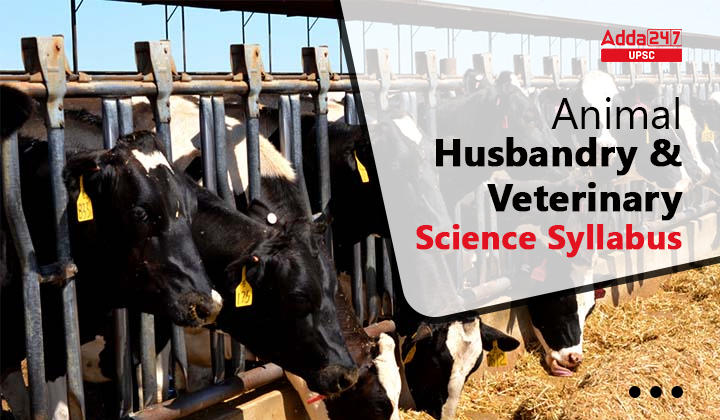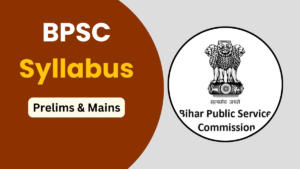Table of Contents
The UPSC Civil Services Mains Exam offers Animal Husbandry and Veterinary Science as an optional subject, comprising two papers: Paper I and Paper II. Paper I covers topics such as animal nutrition, reproduction, physiology, livestock production and management, and genetics and animal breeding. Paper II includes topics like anatomy, hygiene, pharmacology, animal diseases, milk products, veterinary public health, and related technologies, as well as meat hygiene and its associated technology.
It is a highly specialized field, ideally suited for candidates with a background in animal husbandry and veterinary science at the graduate level you should
UPSC Animal Husbandry and Veterinary Science Syllabus 2024
Given the specialized nature of Animal Husbandry & Veterinary Science, candidates should adopt a strategic approach while preparing for the UPSC Animal Husbandry and Veterinary Science Syllabus 2024 Optional Paper. The UPSC Civil Services Mains Exam has Animal Husbandry & Veterinary Science as an optional subject consisting of two papers, Paper I and Paper II, each carrying 250 marks, making a total of 500 marks. It is a highly specialized field, ideally suited for candidates with a background in veterniary sciences at the graduate level.
UPSC Animal Husbandry and Veterinary Science Syllabus For Optional PAPER-I
1. Animal Nutrition:
- Partitioning of food energy within the animal. Direct and indirect calorimetry. Carbon – nitrogen balance and comparative slaughter methods. Systems for expressing the energy value of foods in ruminants, pigs, and poultry. Energy requirements for maintenance, growth, pregnancy, lactation, egg, wool, and meat production.
- Latest advances in protein nutrition. Energy protein interrelationships. Evaluation of protein quality. Use of NPN compounds in ruminant diets. Protein requirements for maintenance, growth, pregnancy, lactation, egg, wool, and meat production.
- Major and trace minerals – Their sources, physiological functions, and deficiency symptoms. Toxic minerals. Mineral interactions. Role of fat-soluble and water-soluble vitamins in the body, their sources, and deficiency symptoms.
- Feed additives – methane inhibitors, probiotics, enzymes, antibiotics, hormones, oligosaccharides, antioxidants, emulsifiers, mold inhibitors, buffers, etc. Use and abuse of growth promoters like hormones and antibiotics – latest concepts.
- Conservation of fodders. Storage of feeds and feed ingredients. Recent advances in feed technology and feed processing. Anti-nutritional and toxic factors present in livestock feeds. Feed analysis and quality control. Digestibility trials – direct, indirect, and indicator methods. Predicting feed intake in grazing animals.
- Advances in ruminant nutrition. Nutrient requirements. Balanced rations. Feeding of calves, pregnant, work animals, and breeding bulls. Strategies for feeding milch animals during different stages of the lactation cycle. Effect of feeding on milk composition. Feeding of goats for meat and milk production. Feeding sheep for meat and wool production.
- Swine Nutrition. Nutrient requirements. Creep, starter, grower, and finisher rations. Feeding of pigs for lean meat production. Low-cost rations for swine.
- Poultry nutrition. Special features of poultry nutrition. Nutrient requirements for meat and egg production. Formulation of rations for different classes of layers and broilers.
2. Animal Physiology
- Physiology of blood and its circulation, respiration; and excretion. Endocrine glands in health and disease.
- Blood constituents.-Properties and functions-blood cell formation-Haemoglobin synthesis and chemistry-plasma proteins production, classification, and properties, coagulation of blood; Haemorrhagic disorders-anticoagulants-blood groups-Blood volume-Plasma expanders-Buffer systems in blood. Biochemical tests and their significance in disease diagnosis.
- Circulation. – Physiology of heart, cardiac cycle, heart sounds, heart beat, electrocardiograms. Work and efficiency of the effect of ions on heart function-metabolism of cardiac muscle, nervous and chemical regulation of heart, the effect of temperature and stress on heart, blood pressure, hypertension, osmotic regulation, arterial pulse, vasomotor regulation of circulation, shock. Coronary and pulmonary circulation, Blood-Brain barrier- Cerebrospinal fluid- circulation in birds.
- Respiration. – Mechanism of respiration, Transport, and exchange of gases –neural control of respiration-chemo-receptors-hypoxia-respiration in birds.
- Excretion-Structure and function of kidney-formation of urine-methods of studying renal function regulation of acid-base balance: physiological constituents of urine-renal failure-passive venous congestion-Urinary secretion in chicken-Sweat glands and their function. Bio-chemical test for urinary dysfunction.
- Endocrine glands. -Functional disorders their symptoms and diagnosis. Synthesis of hormones, mechanism and control of secretion- hormonal receptors-classification and function.
- Growth and Animal Production– Prenatal and postnatal growth, maturation, growth curves, measures of growth, factors affecting growth, conformation, body composition, and meat quality.
- Physiology of Milk Production, Reproduction, and Digestion- Current status of hormonal control of mammary development, milk secretion, and milk ejection, Male and Female reproductive organs, their components and functions. Digestive organs and their functions.
- Environmental Physiology– Physiological relations and their regulation; mechanisms of adaptation, environmental factors and regulatory mechanisms involved in animal behaviour, climatology – various parameters and their importance. Animal ecology. Physiology of behavior. Effect of stress on health and production.
Also Read:
3. Animal Reproduction
- Semen quality– Preservation and Artificial Insemination- Components of semen, composition of spermatozoa, chemical and physical properties of ejaculated semen, factors affecting semen in vivo and in vitro. Factors affecting semen production and quality, preservation, composition of diluents, sperm concentration, and transport of diluted semen. Deep freezing techniques in cows, sheep, goats, swine, and poultry. Detection of oestrus and time of insemination for better conception. Anoestrus and repeat breeding.
4. Livestock Production and Management
- Commercial Dairy Farming– Comparison of dairy farming in India with advanced countries. Dairying under mixed farming and as specialized farming, economic dairy farming. Starting of a dairy farm, Capital and land requirement, organization of the dairy farm. Opportunities in dairy farming, factors determining the efficiency of dairy animals. Herd recording, budgeting, cost of milk production, pricing policy; Personnel Management. Developing Practical and Economic rations for dairy cattle; supply of greens throughout the year, feed and fodder requirements of Dairy Farm. Feeding regimes for young stock and bulls, heifers, and breeding animals; new trends in feeding young and adult stock; Feeding records.
- Commercial meat, egg, and wool production– Development of practical and economic rations for sheep, goats, pigs, rabbits, and poultry. Supply of greens, fodder, and feeding regimes for young and mature stock. New trends in enhancing production and management. Capital and land requirements and socio-economic concept.
- Feeding and management of animals under drought, flood, and other natural calamities.
5. Genetics and Animal Breeding
- History of animal genetics. Mitosis and Meiosis: Mendelian inheritance; deviations to Mendelian genetics; Expression of genes; Linkage and crossing over; Sex determination, sex influenced and sex limited characters; Blood groups and polymorphism; Chromosome aberrations; Cytoplasmic inheritance. Gene and its structure; DNA as a genetic material; Genetic code and protein synthesis; Recombinant DNA technology. Mutations, types of mutations, methods for detecting mutations, and mutation rate. Transgenesis.
- Population Genetics Applied to Animal Breeding– Quantitative Vs. qualitative traits; Hardy Weinberg Law; Population Vs. individual; Gene and genotypic frequency; Forces changing gene frequency; Random drift and small populations; Theory of path coefficient; Inbreeding, methods of estimating inbreeding coefficient, systems of inbreeding, Effective population size; Breeding value, estimation of breeding value, dominance, and epistatic deviation; Partitioning of variation; Genotype X environment correlation and genotype X environment interaction; the role of multiple measurements; Resemblance between relatives.
- Breeding Systems– Breeds of livestock and Poultry. Heritability, repeatability, and genetic and phenotypic correlations, their methods of estimation and precision of estimates; Aids to selection and their relative merits; Individual, pedigree, family, and within family selection; Progeny testing; Methods of selection; Construction of selection indices and their uses; Comparative evaluation of genetic gains through various selection methods; Indirect selection and correlated response; Inbreeding, outbreeding, upgrading, cross-breeding and synthesis of breeds; Crossing of inbred lines for commercial production; Selection for general and specific combining ability; Breeding for threshold characters. Sire index.
6. Extension
- Basic philosophy, objectives, concept, and principles of extension. Different Methods were adopted to educate farmers under rural conditions. Generation of technology, its transfer, and feedback. Problems and constraints in transfer of technology. Animal husbandry programs for rural development.
UPSC Animal Husbandry and Veterinary Science Syllabus For Optional PAPER-II
1. Anatomy, Pharmacology, and Hygiene
- Histology and Histological Techniques: Paraffin embedding technique of tissue processing and H.E. staining – Freezing microtomy- Microscopy-Bright field microscope and electron microscope. Cytology-structure of cells, organelles, and inclusions; cell division-cell types- Tissues and their classification-embryonic and adult tissues-Comparative histology of organs-Vascular. Nervous, digestive, respiratory, musculoskeletal, and urogenital systems- Endocrine glands -Integuments-sense organs.
- Embryology – Embryology of vertebrates with special reference to aves and domestic mammals gametogenesis-fertilization-germ layers- fetal membranes and placentation-types of the placenta in domestic mammals-Teratology-twins and twinning- organogenesis -germ layer derivatives- endodermal, mesodermal and ectodermal derivates.
- Bovine Anatomy– Regional Anatomy: Paranasal sinuses of OX- surface anatomy of salivary glands. Regional anatomy of infraorbital, maxillary, mandibuloalveolar, mental, and cornual nerve block. Regional anatomy of paravertebral nerves, pudendal nerve, median ulnar and radial nerves-tibial, fibular, and digital nerves-Cranial nerves-structures involved in epidural anesthesia-superficial lymph nodes-surface anatomy of visceral organs of thoracic, abdominal and pelvic cavities-comparative features of locomotor apparatus and their application in the biomechanics of the mammalian body.
- Anatomy of Fowl– Musculo-skeletal system-functional anatomy in relation to respiration and flying, digestion, and egg production.
- Pharmacology and therapeutic drugs – Cellular level of pharmacodynamics and pharmacokinetics. Drugs acting on fluids and electrolyte balance. Drugs acting on the Autonomic nervous system. Modern concepts of anesthesia and dissociative anaesthetics. Autacoids. Antimicrobials and principles of chemotherapy in microbial infections. Use of hormones in therapeutics- chemotherapy of parasitic infections. Drug and economic concerns in the Edible tissues of animals- chemotherapy of Neoplastic diseases. Toxicity due to insecticides, plants, metals, non-metals, zootoxins, and mycotoxins.
- Veterinary Hygiene with reference to water, air, and habitation – Assessment of pollution of water, air, and soil- Importance of climate in animal health- effect of environment on animal function and performance between industrialization and animal agriculture- animal housing requirements for specific categories of domestic animals viz. pregnant cows and sows, milking cows, broiler birds- stress, strain and productivity in relation to animal habitation.
2. Animal Diseases
- Etiology, epidemiology pathogenesis, symptoms, postmortem lesions, diagnosis, and control of infectious diseases of cattle, sheep and goat, horses, pigs, and poultry.
- Etiology, epidemiology, symptoms, diagnosis, treatment of production diseases of cattle, horse, pig, and poultry.
- Deficiency diseases of domestic animals and birds.
- Diagnosis and treatment of non-specific conditions like impaction, Bloat, diarrhea, Indigestion, dehydration, stroke, and poisoning.
- Diagnosis and treatment of neurological disorders.
- Principles and methods of immunization of animals against specific diseases– herd immunity- disease-free zones- ‘zero’ disease concept- chemoprophylaxis.
- Anesthesia– local, regional, and general-pre-anesthetic medication. Symptoms and surgical interference in fractures and dislocation. Hernia, choking abomasal displacement- Caesarian operations. Rumenotomy-Castrations.
- Disease investigation techniques.– Materials for laboratory investigation- Establishment of Animal Health Centers- Disease-free zone-
3. Veterinary Public Health
- Zoonoses. – Classification, definition, role of animals and birds in prevalence and transmission of zoonotic diseases- occupational zoonotic diseases.
- Epidemiology– Principle, the definition of epidemiological terms, application of epidemiological measures in the study of diseases, and disease control. Epidemiological features of air, water, and foodborne infections. OIE regulations, WTO, sanitary and phytosanitary measures.
- Veterinary Jurisprudence– Rules and Regulations for improvement of animal quality and prevention of animal diseases – State and central rules for prevention of animal and animal product borne diseases- S P C A- Veterolegal cases- Certificates -Materials and Methods of collection of samples for veterolegal investigation.
4. Milk and Milk Products Technology
- Market Milk: Quality, testing, and grading of raw milk. Processing, packaging, storing, distribution, marketing, defects, and their control. Preparation of the following milk: Pasteurized, standardized, toned, double-toned, sterilized, homogenized, reconstituted, recombined, and flavoured milk. Preparation of cultured milk, cultures, and their management, yoghurt, Dahi, Lassi, and Srikhand. Preparation of flavoured and sterilized milk. Legal standards. Sanitation requirements for clean and safe milk and for the milk plant equipment.
- Milk Products Technology.– Selection of raw materials, processing, storing, distributing, and marketing milk products such as Cream, Butter, Ghee, Khoa, Channa, Cheese, condensed, evaporated, dried milk and baby food, Ice cream and Kulfi; by-products, whey products, buttermilk, lactose, and casein. Testing, grading, and judging milk products- BIS and Agmark specifications, legal standards, quality control, and nutritive properties. Packaging, processing, and operational control. Costing of dairy products.
5. Meat Hygiene and Technology
In the table below we have provided the separate syllabus for the Meat Hygiene and Technology Topic.
| Meat Hygiene: | Meat Technology |
|
|
Aspirants should make a note that though the Vet science may be high scoring subject but regular mocks and practice is required along with the PYQ and best coaching materials .
Related Articles –
| UPSC mains syllabus | UPSC Anthro syllabus |
| UPSC Economics syllabus | UPSC philosophy syllabus |
| UPSC History Syllabus | UPSC Botany syllabus |
| UPSC Geography syllabus | UPSC English syllabus |



 APSC Syllabus 2025, Download Prelims And...
APSC Syllabus 2025, Download Prelims And...
 Punjab PCS Syllabus 2025, New Prelims an...
Punjab PCS Syllabus 2025, New Prelims an...
 BPSC Syllabus 2025 and Exam Pattern For ...
BPSC Syllabus 2025 and Exam Pattern For ...




